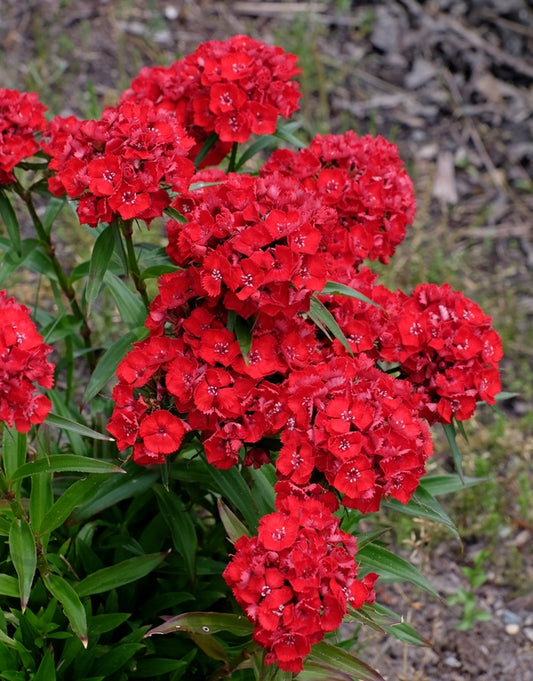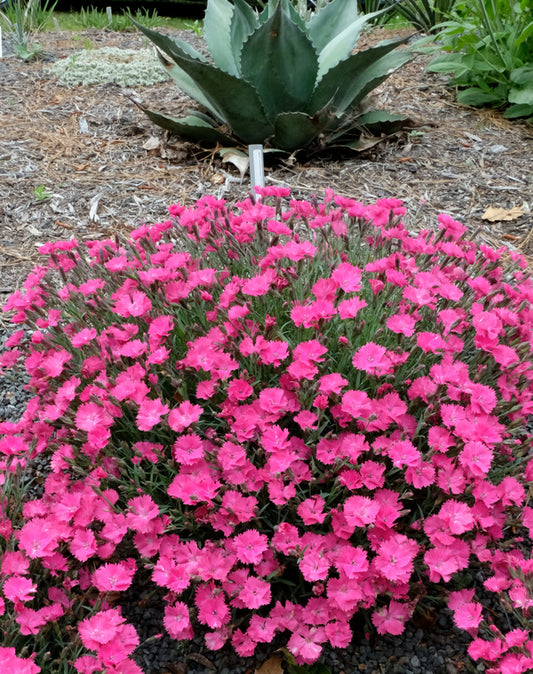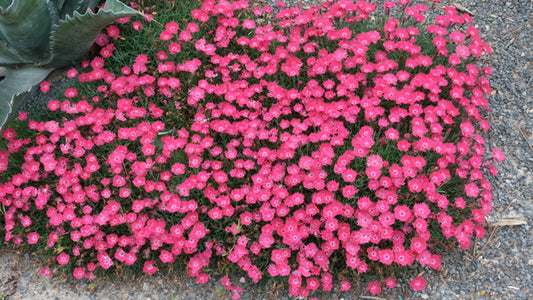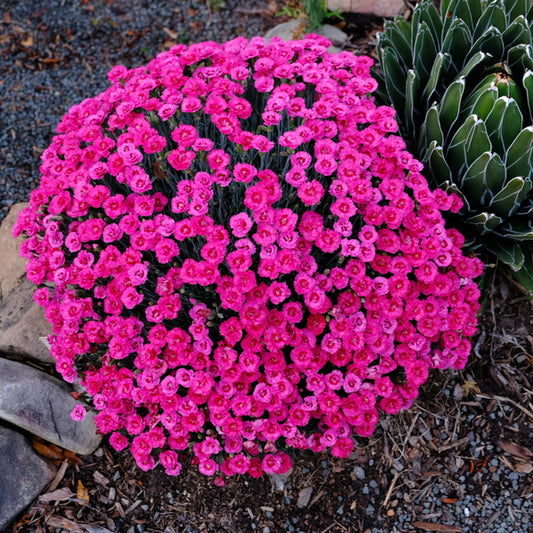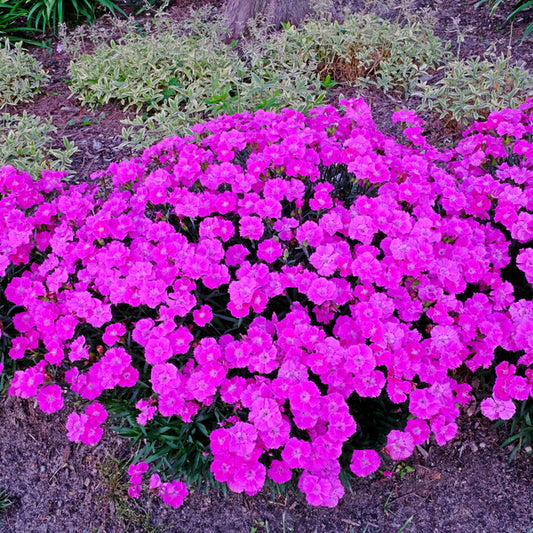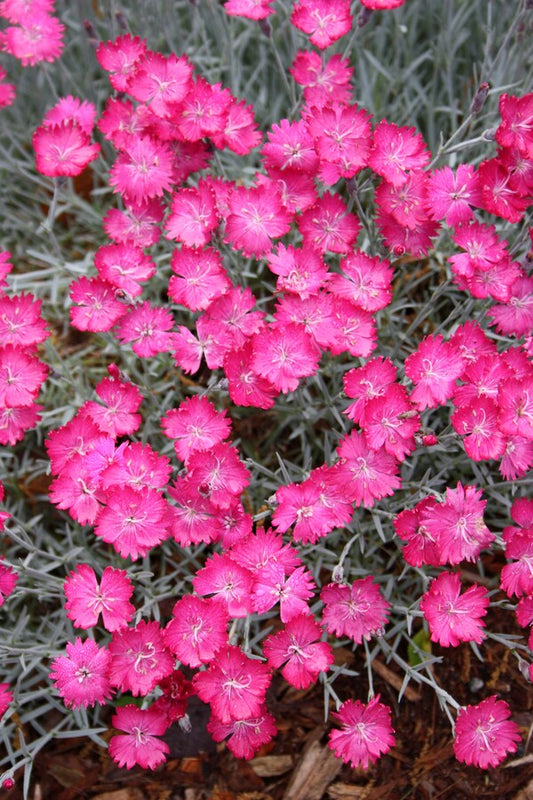Dianthus are loved for their fragrant flowers that perfume the garden in spring. Dianthus flower color ranges from white to pink to red to purple. The flowers attract both butterflies and hummingbirds.
-
Dianthus barbatus 'Scarlet Fever' PP 30,454
Item #: 13199
Zones: 4a to 8b, at least
Dormancy: Evergreen
Height: 12" tall
Culture: Sun
Origin: Southern Europe
Pot Size: 3.5" pot (24 fl. oz/0.7 L)
Regular price $21.00Regular priceUnit price per -
Dianthus 'Bright Light' PP 28,239
Item #: 15028
Zones: 4a to 8b
Dormancy: Evergreen
Height: 10" tall
Culture: Sun
Origin: Hybrid
Pot Size: 3.5" pot (24 fl. oz/0.7 L)
Regular price $21.00Regular priceUnit price per -
Dianthus 'Cherry Charm' PP 30,871
Item #: 15027
Zones: 5a to 8b
Dormancy: Evergreen
Height: 8" tall
Culture: Sun
Origin: Hybrid
Pot Size: 3.5" pot (24 fl. oz/0.7 L)
Regular price $21.00Regular priceUnit price per -
Dianthus 'Razzlepop'
Item #: 17008
Zones: 3a to 8a
Dormancy: Evergreen
Height: 12" tall
Culture: Sun
Origin: Hybrid
Pot Size: 3.5" pot (24 fl. oz/0.7 L)
Regular price $21.00Regular priceUnit price per -
Dianthus 'Rose Bouquet' PP 30,274
Item #: 15891
Zones: 3a to 9b
Dormancy: Evergreen
Height: 8" tall
Culture: Sun
Origin: Hybrid
Pot Size: 3.5" pot (24 fl. oz/0.7 L)
Regular price $21.00Regular priceUnit price per -
Dianthus 'Wicked Witch' PP 19,824
Item #: 5426
Zones: 3a to 9b
Dormancy: Evergreen
Height: 8" tall
Culture: Sun
Origin: Hybrid
Pot Size: 3.5" pot (24 fl. oz/0.7 L)
Regular price $21.00Regular priceUnit price per
More Information About Dianthus
Dianthus is a genus prized around the world for its frilly flowers and mostly evergreen leaves that are often chalky-blue in color. Although some are used as annuals or biennials, most modern dianthus plants are sterile which turns them into reliable perennials. They generally prefer places that have cool dry summers, but we have collected specimens that are good in the south...tolerant of heat and humidity.
Dianthus are beloved for their clove-scented, fragrant flowers that perfume the garden in spring. Flower color ranges from white to pink to red to purple and sometimes bicolor. Although dianthus flowers are usually less than 2 inches across, there are often hundreds of them covering the plant during peak bloom time resulting in a stunning visual impact. They primarily flower in the spring but some perennial dianthus will re-bloom in the summer and fall in favorable conditions (i.e., deadheading and cool summers). They also have flowers that attract butterflies and hummingbirds.
For us, growing dianthus in our heat and humidity has always been a challenge, even in well-drained soils. We are always excited when we find a specimen that performs as well for us as it does in cooler climates. We offer only the best selections from of our heat and humidity tolerance trials for sale.
How to Grow Dianthus
- Sun - Full sun is best. Partial sun also works.
- Soil - This is the key to keeping dianthus alive in the hot, humid, south. Well-drained. Well-drained. Well-drained. Many varieties actually prefer rock gardens. Neutral to slightly sweet soil is best but some acidity is well tolerated. A little mulch is okay as long as it does not touch the crown...that will promote rot. They are light feeders so a little compost once per year is all that is needed.
- Water - Dianthus is drought tolerant, but regular watering in the spring and summer results in the least stressed, best performing plants. When overhead watering, keep the leaves dry to minimize spotting. Soils that are kept too wet will kill the plant, especially in winter.
- Pruning - None needed for the modern sterile cultivars. If you crave tidiness, you can clip the spent flower heads. If done early enough in the summer, deadheading also tends to trigger fall reblooming. Older fertile cultivars will re-seed around the garden unless deadheaded in a timely manner.
- Pests - Dianthus is remarkably pest free. Deer do not eat them but rabbits do.
- Propagation - Division or tip cuttings. Dividing also helps rejuvenate a stagnant clump. Layering of the long stems will work too.
- Design Tips - Most dianthus are small plants that will spread just a little bit if they are stress-free and happy. This plant looks great spilling over the edge of a wall or container. And they do very well on hillsides or rock gardens where they can get the good drainage that they crave.
- Cut Flowers - Yeah, you bet-ya! Fragrant too!


